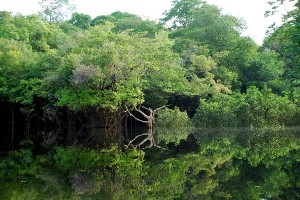SUNDAY, 15 AUGUST 2010
A single hectare of the Amazonian rainforest may be home to several hundred species of tree, and because trees are at the centre of ecological communities, their diversity translates to variety in the organisms they support. The diversity of tree species is maintained by negative feedback processes in the local environment: seedlings growing close to members of their own species are kept in check by the accumulation of species-specific herbivores and pathogens that limit their survival. Although these patterns of negative feedback have been well documented, the biological mechanisms that control them have not been fully elucidated.Two recent studies of tropical tree communities in Panama have addressed this issue. By measuring survival close to trees of the same and different species, Comita and coworkers confirm in Science [1] that seedlings were much more likely to die when they grow close to neighbouring trees of their own species. A second study, published by Mangan and colleagues in Nature [2] showed that soil-dwelling organisms were responsible for the differences in mortality. Both studies found that the strength of the negative feedback constraints varied for different species, but unexpectedly, it was the rare species in the community that were most susceptible. This means that the relative abundances observed today are the result and not the cause of the negative feedback, with susceptibility to soil biota emerging as a major force in determining relative species abundance. Furthermore, the reports demonstrated that the strength of the feedback is sufficient to have a community-wide effect. This has important implications for conservation efforts, where an understanding of the mechanisms that control species abundances are essential, particularly because the rarest species have the least ability to regenerate.
Written by Robert Jones
References:
- L. S. Comita et al., “Asymmetric Density Dependence Shapes Species Abundances in a Tropical Tree Community,” Science 329, no. 5989 (2010): 330-332.
- Scott A. Mangan et al., “Negative plant–soil feedback predicts tree-species relative abundance in a tropical forest,” Nature 466, no. 7307 (2010): 752-755.

